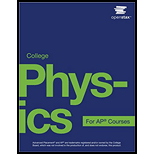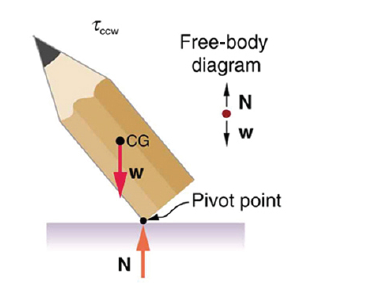
College Physics For Ap® Courses
16th Edition
ISBN: 9781938168932
Author: Gregg Wolfe, Irina Lyublinskaya, Douglas Ingram
Publisher: OpenStax
expand_more
expand_more
format_list_bulleted
Concept explainers
Textbook Question
Chapter 9, Problem 6CQ
A round pencil lying on its side as in Figure 9.13 is in neutral equilibrium relative to displacements perpendicular to its length. What is its stability displacements parallel to its length?

Figure 9.13 If the pencil is displaced too far, the torque caused by its weight changes direction to counterclockwise and causes the displacement to increase.
Expert Solution & Answer
Trending nowThis is a popular solution!

Students have asked these similar questions
Just 5 and 6 don't mind 7
In an electron gun, electrons are accelerated through a region with an electric field of magnitude 1.5 × 104 N/C for a distance of 2.5 cm. If the electrons start from rest, how fast are they moving after traversing the gun?
Please solve and answer this problem correctly please. Thank you!!
Chapter 9 Solutions
College Physics For Ap® Courses
Ch. 9 - What can you say about the velocity of a moving...Ch. 9 - Under what conditions can a rotating body be in...Ch. 9 - What three factors affect the torque created by a...Ch. 9 - A wrecking ball is being used to knock down a...Ch. 9 - Mechanics put a length of Pipe over the handle of...Ch. 9 - A round pencil lying on its side as in Figure 9.13...Ch. 9 - Explain the need for tall towers on a suspension...Ch. 9 - When visiting some countries, you may see a person...Ch. 9 - Scissors are like a double-lever "Stem, Which of...Ch. 9 - Suppose you pull a nail at a constant rate using a...
Ch. 9 - Why are the forces exerted on the outside world by...Ch. 9 - Explain why the forces in our joints are several...Ch. 9 - Why are the forces exerted on the outside world by...Ch. 9 - Explain why the forces in our joints are several...Ch. 9 - Certain of dinosaurs were bipedal (walked on two...Ch. 9 - Swimmers and athletes during competition need to...Ch. 9 - If the maximum force the biceps muscle can exert...Ch. 9 - Suppose the biceps muscle was attached through...Ch. 9 - Explain one of the reasons why pregnant women...Ch. 9 - (a) When opening a door, you push on it...Ch. 9 - When tightening a bolt, you push perpendicularly...Ch. 9 - Two children push on opposite sides of a door...Ch. 9 - Use the second condition for equilibrium (net =0 )...Ch. 9 - Repeat the seesaw problem in Example 9.1 with the...Ch. 9 - Suppose a horse leans against a wall as in Figure...Ch. 9 - Two children of mass 20.0 kg and 30.0 kg sit...Ch. 9 - (a) Calculate the magnitude and direction of the...Ch. 9 - A person carries a plank of wood 2.00 m long with...Ch. 9 - A 17.0-m-high and 11.0-m-long wall under...Ch. 9 - (a) What force must be exerted by the wind to...Ch. 9 - Suppose the weight of the drawbridge in Figure...Ch. 9 - Suppose a 900-kg car is on the bridge in Figure...Ch. 9 - A sandwich board advertising sign is constructed...Ch. 9 - (a) What minimum coefficient of friction is needed...Ch. 9 - A gymnast is attempting to perform splits. From...Ch. 9 - To get up on the roof, a person (mass 70.0 kg)...Ch. 9 - In Figure 9.21, the cg of the pole held by the...Ch. 9 - What is the mechanical advantage of a nail puller...Ch. 9 - Suppose you needed to raise a 250-kg mower a...Ch. 9 - a) What is the mechanical advantage of a...Ch. 9 - A typical car has an axle with 1.10 cm radius...Ch. 9 - What force does the nail puller in Exercise 9.19...Ch. 9 - If you used an ideal pulley of the type shown in...Ch. 9 - Repeat Exercise 9.24 for the pulley shown in...Ch. 9 - Verity that the force in the elbow joint in...Ch. 9 - Two muscles in the back of the leg pull on the...Ch. 9 - The upper leg muscle (quadriceps) exerts a force...Ch. 9 - A device for exercising the upper leg muscle is...Ch. 9 - A person working at a drafting board may hold her...Ch. 9 - We analyzed the biceps muscle example with the...Ch. 9 - Even when the head is held erect, as in Figure...Ch. 9 - A 75-kg man stands on his toes by exerting an...Ch. 9 - A father lifts his child as shown in Figure 9.43....Ch. 9 - Unlike most of the other muscles in our bodies,...Ch. 9 - Integrated Concepts Suppose we replace the 4.0-kg...Ch. 9 - (a) What force should the woman in Figure 9.45...Ch. 9 - You have just planted a sturdy 2-m-tall palm tree...Ch. 9 - Unreasonable Results Suppose two children are...Ch. 9 - Construct Your Own Problem Consider a method for...
Additional Science Textbook Solutions
Find more solutions based on key concepts
8. Studies of DNA support which of the following?
a. Members of the group called australopiths were the first t...
Campbell Biology: Concepts & Connections (9th Edition)
Body, Heal Thyself The precision of mitotic cell division is essential for repairing damaged tissues like those...
Biology: Life on Earth with Physiology (11th Edition)
CAUTION Why does the presence of extinct forms and transitional features in the fossil record support the patte...
Biological Science (6th Edition)
A geneticist from an alien planet that prohibits genetic research brought with him to Earth two pure-breeding l...
Concepts of Genetics (12th Edition)
Glycine has pK2 values of 2.34 and 9.60. At what pH does glycine exist in the forms shown?
Organic Chemistry (8th Edition)
Why is it necessary to be in a pressurized cabin when flying at 30,000 feet?
Anatomy & Physiology (6th Edition)
Knowledge Booster
Learn more about
Need a deep-dive on the concept behind this application? Look no further. Learn more about this topic, physics and related others by exploring similar questions and additional content below.Similar questions
- Please solve and answer this problem correctly please. Thank you!!arrow_forwarda) Use the node-voltage method to find v1, v2, and v3 in the circuit in Fig. P4.14. b) How much power does the 40 V voltage source deliver to the circuit? Figure P4.14 302 202 w w + + + 40 V V1 80 Ω 02 ΣΑΩ 28 A V3 + w w 102 202arrow_forwardPlease solve and answer this problem correctly please. Thank you!!arrow_forward
- You're on an interplanetary mission, in an orbit around the Sun. Suppose you make a maneuver that brings your perihelion in closer to the Sun but leaves your aphelion unchanged. Then you must have Question 2 options: sped up at perihelion sped up at aphelion slowed down at perihelion slowed down at aphelionarrow_forwardThe force of the quadriceps (Fq) and force of the patellar tendon (Fp) is identical (i.e., 1000 N each). In the figure below angle in blue is Θ and the in green is half Θ (i.e., Θ/2). A) Calculate the patellar reaction force (i.e., R resultant vector is the sum of the horizontal component of the quadriceps and patellar tendon force) at the following joint angles: you need to provide a diagram showing the vector and its components for each part. a1) Θ = 160 degrees, a2) Θ = 90 degrees. NOTE: USE ONLY TRIGNOMETRIC FUNCTIONS (SIN/TAN/COS, NO LAW OF COSINES, NO COMPLICATED ALGEBRAIC EQUATIONS OR ANYTHING ELSE, ETC. Question A has 2 parts!arrow_forwardThe force of the quadriceps (Fq) and force of the patellar tendon (Fp) is identical (i.e., 1000 N each). In the figure below angle in blue is Θ and the in green is half Θ (i.e., Θ/2). A) Calculate the patellar reaction force (i.e., R resultant vector is the sum of the horizontal component of the quadriceps and patellar tendon force) at the following joint angles: you need to provide a diagram showing the vector and its components for each part. a1) Θ = 160 degrees, a2) Θ = 90 degrees. NOTE: USE DO NOT USE LAW OF COSINES, NO COMPLICATED ALGEBRAIC EQUATIONS OR ANYTHING ELSE, ETC. Question A has 2 parts!arrow_forward
- No chatgpt pls will upvotearrow_forwardThe force of the quadriceps (Fq) and force of the patellar tendon (Fp) is identical (i.e., 1000 N each). In the figure below angle in blue is Θ and the in green is half Θ (i.e., Θ/2). A) Calculate the patellar reaction force (i.e., R resultant vector is the sum of the horizontal component of the quadriceps and patellar tendon force) at the following joint angles: you need to provide a diagram showing the vector and its components for each part. a1) Θ = 160 degrees, a2) Θ = 90 degrees. NOTE: USE ONLY TRIGNOMETRIC FUNCTIONS (SIN/TAN/COS, NO LAW OF COSINES, NO COMPLICATED ALGEBRAIC EQUATIONS OR ANYTHING ELSE, ETC. Question A has 2 parts!arrow_forwardNo chatgpt pls will upvotearrow_forward
- No chatgpt pls will upvotearrow_forwardSolve and answer the question correctly please. Thank you!!arrow_forward་ The position of a particle is described by r = (300e 0.5t) mm and 0 = (0.3t²) rad, where t is in seconds. Part A Determine the magnitude of the particle's velocity at the instant t = 1.5 s. Express your answer to three significant figures and include the appropriate units. v = Value Submit Request Answer Part B ? Units Determine the magnitude of the particle's acceleration at the instant t = 1.5 s. Express your answer to three significant figures and include the appropriate units. a = Value A ? Unitsarrow_forward
arrow_back_ios
SEE MORE QUESTIONS
arrow_forward_ios
Recommended textbooks for you
 University Physics Volume 1PhysicsISBN:9781938168277Author:William Moebs, Samuel J. Ling, Jeff SannyPublisher:OpenStax - Rice University
University Physics Volume 1PhysicsISBN:9781938168277Author:William Moebs, Samuel J. Ling, Jeff SannyPublisher:OpenStax - Rice University Principles of Physics: A Calculus-Based TextPhysicsISBN:9781133104261Author:Raymond A. Serway, John W. JewettPublisher:Cengage Learning
Principles of Physics: A Calculus-Based TextPhysicsISBN:9781133104261Author:Raymond A. Serway, John W. JewettPublisher:Cengage Learning Physics for Scientists and Engineers: Foundations...PhysicsISBN:9781133939146Author:Katz, Debora M.Publisher:Cengage Learning
Physics for Scientists and Engineers: Foundations...PhysicsISBN:9781133939146Author:Katz, Debora M.Publisher:Cengage Learning Glencoe Physics: Principles and Problems, Student...PhysicsISBN:9780078807213Author:Paul W. ZitzewitzPublisher:Glencoe/McGraw-Hill
Glencoe Physics: Principles and Problems, Student...PhysicsISBN:9780078807213Author:Paul W. ZitzewitzPublisher:Glencoe/McGraw-Hill Physics for Scientists and Engineers, Technology ...PhysicsISBN:9781305116399Author:Raymond A. Serway, John W. JewettPublisher:Cengage Learning
Physics for Scientists and Engineers, Technology ...PhysicsISBN:9781305116399Author:Raymond A. Serway, John W. JewettPublisher:Cengage Learning Classical Dynamics of Particles and SystemsPhysicsISBN:9780534408961Author:Stephen T. Thornton, Jerry B. MarionPublisher:Cengage Learning
Classical Dynamics of Particles and SystemsPhysicsISBN:9780534408961Author:Stephen T. Thornton, Jerry B. MarionPublisher:Cengage Learning

University Physics Volume 1
Physics
ISBN:9781938168277
Author:William Moebs, Samuel J. Ling, Jeff Sanny
Publisher:OpenStax - Rice University

Principles of Physics: A Calculus-Based Text
Physics
ISBN:9781133104261
Author:Raymond A. Serway, John W. Jewett
Publisher:Cengage Learning

Physics for Scientists and Engineers: Foundations...
Physics
ISBN:9781133939146
Author:Katz, Debora M.
Publisher:Cengage Learning

Glencoe Physics: Principles and Problems, Student...
Physics
ISBN:9780078807213
Author:Paul W. Zitzewitz
Publisher:Glencoe/McGraw-Hill

Physics for Scientists and Engineers, Technology ...
Physics
ISBN:9781305116399
Author:Raymond A. Serway, John W. Jewett
Publisher:Cengage Learning

Classical Dynamics of Particles and Systems
Physics
ISBN:9780534408961
Author:Stephen T. Thornton, Jerry B. Marion
Publisher:Cengage Learning
What is Torque? | Physics | Extraclass.com; Author: Extraclass Official;https://www.youtube.com/watch?v=zXxrAJld9mo;License: Standard YouTube License, CC-BY